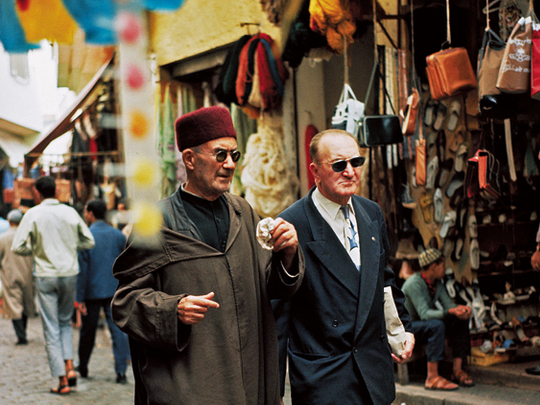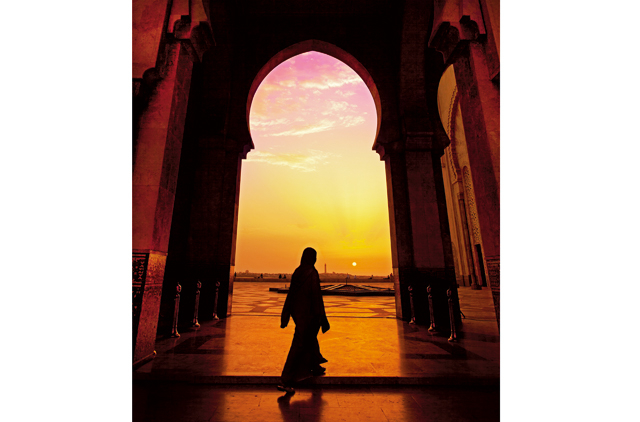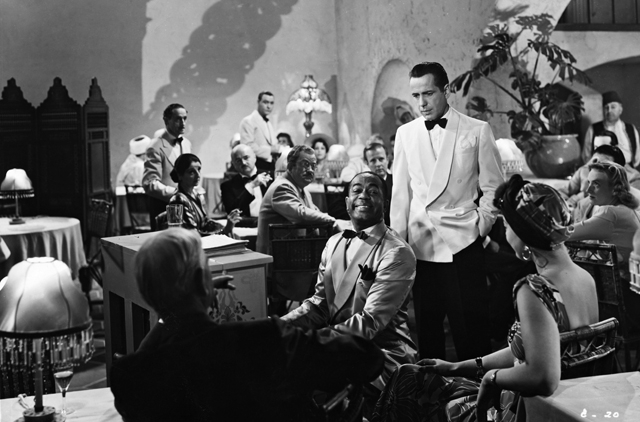
I was desperate to fall madly in love with Casablanca. On my apartment wall I have a framed poster of the 1942 movie classic of the same name, which I've watched more times than is healthy. Who could grow weary of watching Bogart and Bergman's on-screen chemistry? How could you not admire their timeless sartorial panache? And will a writer ever be able to pack more memorable quotes into a screenplay?
"Of all the gin joints in all the towns in all the world, she walks into mine," says Humphrey Bogart's Rick, owner of the eponymous bar. And when I knew I was going to Casablanca, I decided that I would walk into that same gin joint, where the piano would be playing, the air would be thick with Gitanes smoke and the bar would be propped up by louche men in tuxedos and trench coats.
And then came the bombshell.
Days before my flight, I found out that the film was shot on a cramped studio lot in the Hollywood Hills. As for Rick's bar, it never existed. At least not until 2004 when an enterprising Morocco-based American woman, who had obviously made the same disappointing discovery I did, decided to build one out of bricks rather than balsa wood, knowing it would be a bona fide tourist magnet. It was at this point that I realised I had romanticised the city of Casablanca to the point of absurdity.
Arriving late at night after a long flight from Dubai, I found the roads grid-locked, the pot-holed pavements crammed with people. Young, leather jacket-clad Moroccans socialising in and around the city's hundreds of cafés leaned nonchalantly against mopeds, smoking, laughing, eyeing up potential paramours in their brightly coloured hijabs across smog-filled streets.
Casablanca has a lively alfresco café culture. Certainly one to rival that of any city in Italy or France. By day, groups of men, young and old, chat idly. Or read the papers. Or just sit in a line with their backs to the café windows, watching the world go by. They sip espressos or traditional Moroccan tea (a combination of Ceylon leaves and mint) while getting their shoes shined by adolescent hands that should be holding a school pen not a dirty rag.
Poverty is never far away in Africa's 11th most populous city - old men sleeping in shop doorways at night are a common sight - and, like any big city in the developing world, it draws in the jobless from surrounding towns and villages only to chew them up and spit them back out on the street where they are forced to beg from the city's few tourists.
Casablanca, with its chronic shortage of postcard-pretty landmarks, is usually a tourist's afterthought. Atmospheric Marrakech and Fez invariably get the lion's share of visitors to Morocco. The statistics, however, could be in for a shake-up thanks to the recent opening of Morocco Mall, the country's first GCC-style mega mall, replete with luxury retailers, dancing fountains and a giant aquarium. While this is a major boost for the city, it's also sad that Morocco's first Starbucks in a sterile shopping centre could be the first step towards killing off its vibrant, decades-old street cafés.
Already, Casablanca's Berber history seems to have been all but buried beneath concrete and the peripheries of a sprawling port and naval base. Despite being in the heart of the Maghreb region, its streets are redolent of Paris - a forlorn, crumbling post-war Paris crying out for a good scrub and a battalion of painters to revive the art-deco buildings designed by French architect, Henri Prost, most of which can be found in the Ville Nouvelle (New Town) area of the city. The French influence - Morocco was a protectorate of France from 1912 until 1956 - is everywhere. Not just architecturally but linguistically, with half the Moroccan population able to speak French as well as Arabic and Berber.
Everywhere I went people approached me with a friendly ‘bonjour'. I replied with a mix of stuttering secondary-school French and one of the few Arabic phrases picked up in Dubai: "Je ne comprends pas. Titkallum Inglisi?"
On my second day in the city I set out for the Old Medina, an ancient but recently restored souq in the part of town pre-dating the French protectorate. In warren-like alleyways I found predictable tourist baubles (camel key rings and evil eye bracelets galore) alongside locally made leather products of superior quality and more lampshades than an Ikea factory. In a vast Aladdin's cave of clay pots, ornate cedar wood chests, hookah pipes and tasselled Fez hats, my search for a ‘Made in China' sticker proved satisfyingly fruitless.
Later I went on a bus tour to the old and affluent suburb of Anfa, Casablanca's original name before the marauding Portuguese arrived in the 15th century and re-named it Casa Branca, meaning ‘white house', after the military fortress they eventually built.
It was the Spanish, claiming the city for themselves between 1580 and 1640, who later modified it to Casablanca. The whitewashed residences of Anfa, the city's answer to Beverly Hills according to our exaggeration-prone guide, were certainly a few notches up the real estate ladder from the grime-streaked buildings of the city centre. These immaculate houses in the hills come with well-tended swimming pools, French-shuttered windows and, best of all, sweeping views of the Atlantic Ocean. It was overwhelming to stand there and think that the next land mass across this vast space is North America.
The best place to hang out, relax and breathe in the sea air is undoubtedly the huge courtyard of the Hassan II Mosque. Costing $800 million (Dh2.9 billion) to build, the mosque itself was inaugurated in 1993, 13 years after construction began. At 210 metres, its minaret is said to be the tallest in the world, while the mosque is the world's fifth largest.
In the evenings, hundreds of people of different religious faiths congregate in the courtyard to sit on the high walls that buffer the ocean. If you're not of a nervous disposition, you can dangle your legs precariously over the edge and watch surfers and seagulls share the waves below.
From the mosque I tried walking to the replica of Rick's Bar, bracing myself for disappointment. And disappointed I was. I couldn't find the place. Even with a map and the assistance of a local who insisted he knew every inch of his city, Rick's Bar eluded me. It didn't help that I couldn't find any street names to help me get my bearings.
I ended up outside a heavily guarded government building near the port - and it was starting to rain. Torrential, cold European-style rain that ricochets off the pavement and soaks you to the bone in seconds.
By this point, I was beginning to count the hours until my flight back to Dubai. So I took refuge in a nearby café and got talking to an elderly man called Erdin. He insisted on showing me his brother's "shop" around the corner, which turned out to be a tiny street stall. Once we arrived I paid 90 Moroccan dirhams for a scarf that should have cost 30 - or at least that's what was on the price tag of an identical garment I saw in the shop in the airport duty free. I returned to my hotel in a mood blacker than the sky.
At night, large swathes of Casablanca descend into dubious semi-darkness, the headlights of passing traffic providing more illumination than the sparingly placed street-lamps. During the short walk from my hotel to a restaurant (authentic Moroccan food, it must be said, is delicious and massively underrated) I peered into dingy bars with no names above their doors.
Hands reached out from darkened doorways for spare change. Pint-sized vagabonds tugged my coat sleeves. Old men in traditional Berber djellabas (Jedi knight-style hooded cloaks) ambled around like lost druids. If it all sounds a bit grubby and Dickensian, well, that's because it is.
For anyone who has seen the film but hasn't visited the city, Casablanca will always have an aura of intrigue and romance. Sadly for me, the movie's magic has been irrevocably dispelled by the real thing.
How to get there
Casablanca is a nine-hour flight from the UAE. Emirates flies directly to the city's Mohammed V International Airport. Flying with Etihad costs Dh3,750 at time of writing. The city is a 30-45 minute taxi journey from the airport. A dedicated airport shuttle will take you to the city's main train station, Casa-Voyageurs.
Where to stay
Le Royal Mansour Méridien: Situated in the heart of Casablanca, Le Royal Mansour Méridien is close to United Nations Square, Place Mohammed V, and Hassan II Mosque. www.leroyalmansourmeridien.com
Golden Tulip Farah: Just a five-minute walk from the Old Medina souq, the Golden Tulip is a stylish hotel with a great jazz bar and restaurants serving authentic Moroccan food. www.goldentulipfarahcasablanca.com








